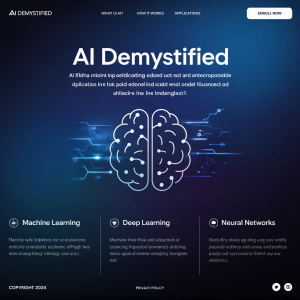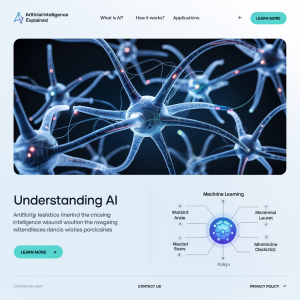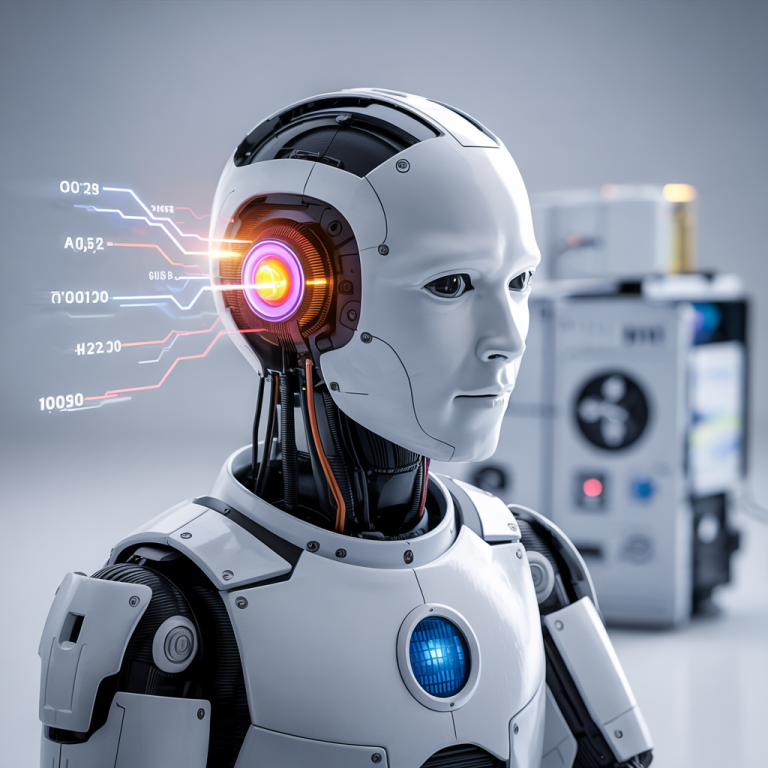One of the most fascinating and revolutionary areas of modern technology is artificial intelligence, or AI.
However, what is it and how does it operate? Fundamentally, artificial intelligence is the capacity of machines—particularly computer systems—to carry out operations that normally call for human intelligence. These tasks include problem-solving, pattern recognition, language comprehension, experience-based learning, and even decision-making. Artificial intelligence (AI) systems are not created with rigid, sequential instructions; rather, they are made to grow and change as they are exposed to more information and experiences.

A Brief History of AI
AI is not a novel idea. It began in the 1950s when pioneers like John McCarthy, Alan Turing, and Marvin Minsky began investigating the possibility of having machines mimic some characteristics of human intellect. Decades of research began with Turing’s well-known query, “Can machines think?” At a meeting held at Dartmouth College in 1956, the term “artificial intelligence” was formally introduced.Since then, AI has experienced both “AI winters,” when interest and funding declined because of few advances, and periods of fast advancement. But during the past 20 years, there has been a significant resurgence in AI due to advancements in algorithms, data availability, and processing power.
How Does Artificial Intelligence Operate?
Fundamentally, AI systems operate by ingesting vast volumes of data, examining it for trends, and then applying those trends to forecast outcomes or make choices. This is made feasible by a number of essential elements:
1. Learning by Machines
One of the primary ways AI systems learn is through machine learning (ML), a subset of artificial intelligence. An ML system is educated utilizing vast volumes of data rather than being explicitly programmed to carry out a task. It employs algorithms to identify trends or connections in the data and gradually enhances its functionality.
For instance, even if a new image differs slightly from the training examples, a machine learning model trained on thousands of cat photos can learn to identify a cat in it.
- Supervised Learning: Learning from labeled data (e.g., images labeled as “cat” or “dog”).
- Unsupervised Learning: Finding patterns in unlabeled data (e.g., grouping customers by purchasing behavior).
- Reinforcement Learning: Learning by trial and error, receiving rewards for good decisions (used in robotics and game-playing AI).
2. Deep Learning and Neural Networks
The architecture of the human brain served as the model for neural network algorithms. They are made up of layers of connected nodes (sometimes called “neurons”) that process information in phases.
A branch of machine learning called “deep learning” makes use of enormous, intricate neural networks, which can include millions of parameters. Significant advancements in domains such as autonomous driving, natural language processing, and picture identification have been attributed to deep learning.
For example, a deep learning model can be used to train virtual assistants like Alexa or Siri to recognize voice patterns.
3. NLP, or natural language processing
AI can comprehend, interpret, and produce human language thanks to natural language processing. It is what makes AI systems capable of writing articles, summarizing documents, translating languages, and powering chatbots.
Complex procedures like named entity recognition (identifying persons, places, or objects), sentiment analysis (identifying emotions in text), and language modeling (predicting the next word in a sentence) are all part of natural language processing (NLP).
4. Visualization
AI’s capacity to decipher and decide on visual information, such as images and movies, is known as computer vision. Self-driving cars, facial recognition software, and medical image analysis are all made possible by this technology.
Using deep learning models that have been trained on enormous datasets of annotated images, it entails teaching robots to “see” and comprehend the visual world.
5. Robotics
Robotics also makes extensive use of AI, which enables machines to sense their surroundings, decide what to do, and take action. Robots with AI capabilities are employed in a wide range of industries, including manufacturing, healthcare (such as surgical robots), and exploration (such as Mars rovers).
Uses of AI in Practical Settings
Our everyday lives are already heavily impacted by AI, frequently in ways we are unaware of. Typical uses include the following:
- Voice assistants, such as Alexa, Siri, and Google Assistant
- Recommendation engines (like Netflix’s movie recommendations and Amazon’s product recommendations)
- Autonomous Vehicles (such as Tesla’s self-driving automobiles)
- Medical diagnostics (such as AI evaluating MRI and X-ray data)
- Financial Services (such as algorithmic trading and fraud detection)
- Customer service (such as using AI chatbots to answer questions from customers)

Difficulties and Moral Aspects
AI has numerous advantages, but it also has drawbacks. Bias is one of the main issues. Unfair or discriminating results may be produced by AI systems that have been trained on biased data. An AI recruiting tool that has been educated on past hiring data, for example, may unjustly give preference to some groups over others.
Because AI automates jobs that were formerly performed by humans, there is also the issue of job displacement. Furthermore, when AI systems have access to a lot of personal data, privacy issues surface.
The development of ethical AI is centered on human rights, responsibility, transparency, and fairness.
The Future of AI
AI has a bright future ahead of it. The goal of artificial general intelligence (AGI) is to create systems that can comprehend and carry out any intellectual endeavor that a human can.
Even though artificial general intelligence (AGI) is still mostly theoretical, current limited AI systems are becoming more potent, improving several businesses and creating new opportunities in fields like education, healthcare, and climate change mitigation.
As AI develops, it will be critical for society to control its growth in a way that maximizes advantages and minimizes risks.

